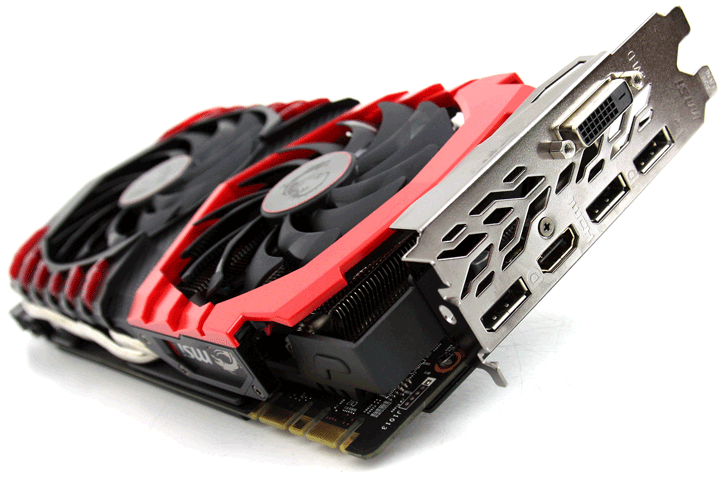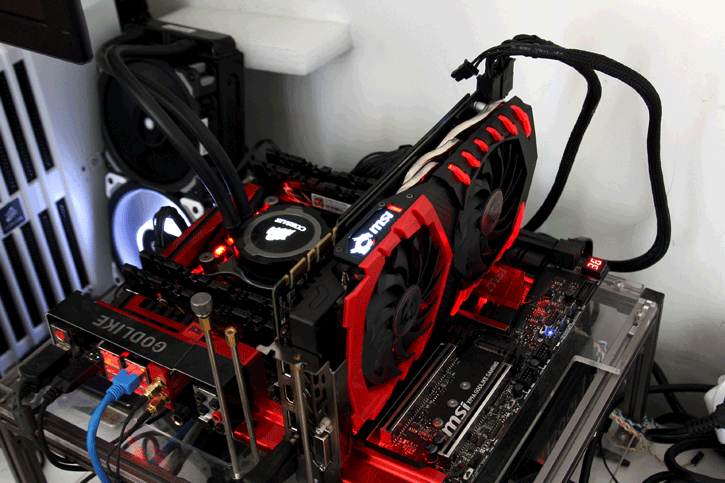Conclusion
Conclusion
The Gaming Z SKU is without doubt the fastest GeFroce GTX 1080 from MSI that your money can get you. However the differences in performance in-between all models is neglectable. I mean to date we have tested like six tweaked SKUs from varying manufacturers and the differences in-between ALL cards are like 3 FPS give or take 1 FPS. The problem with the highest-end SKUs is that they are more expensive, and that extra money just does not justify the little performance gain. We've seen the gaming X in the 769 EURO marker while initial prices for the Z version indicate 799 EURO. That difference you will not see back in performance. Extra features wise you are looking at that higher clock frequency and the LED lit Gaming logo on the back-plate. Really, that's all the difference. Depending on the clock frequency modus you choose to use you may expect that dynamic boost clock hovering at the 1.95 GHz marker with the default clocks and yes that is a notch faster compared to the founder editions. It does seem that the Pascal generation scales a little less compared to Maxwell in terms of relative tweaking/overclocking performance.The memory runs a tiny bit faster, not a lot though. Your biggest benefit obviously is the 8GB memory volume size. Whilst the highest used we ever measured is in the 5 to 6 GB VRAM domain, that 8 GB 256-bit GDDR5X memory is an excellent and well-balanced amount of graphics memory. Keep in mind:
- Enthusiast level gaming requires a lot of graphics memory.
- People simply like gigantic graphics memory buffers.
But hey, who knows with titles like The Division / GTA5 and technologies like Ultra HD and / or DSR versus performance and VRAM what you find valid, or not. High up there in the enthusiast space there certainly is a market for cards like these. That makes these 8 GB models relevant for gaming. And it really is a partition of 8 GB and not 7.5 GB of graphics memory :P
Aesthetics
MSI tweaked the design a bit for the new Gaming X and upcoming Z series, the more stylish TwinFrozr VI cooler looks serious and now comes with RGB LED lighting control. Switch it on/off or to any color and animation you prefer, the choice is yours. Cool dibs is that backplate, with opening at the proper areas (GPU/VRM) for venting. As you can see, I remain skeptical about backplates, they potentially can trap heat and thus warm up the PCB. But the flip-side is that they do look better and can protect your PCB and components from damage. Consumer demand is always decisive, and you guys clearly like graphics cards with backplates. Both the front IO plate and backplate are dark matte black which certainly gives the card that premium feel. All that combined with a nicely design 10 phase PCB again in matte black, and the end result is a lovely looking product. I am however not a fan of the LED lit Gaming logo on the backplate. I would have liked to have seen something more subtle, a dragon stamped as holes in the back-plate lit up in red or something.
Cooling & Noise Levels
The reference design (founder editions) of the GTX 1080 are set at an offset threshold of 80 degrees C. Once the GPU gets warmer the card will clock down / lower its voltage etc to try and keep the card cooler, that's throttling and it part of the design. MSI however throws in a cooler that manages roughly 500 to 600W of cooling performance. It is a really good one, so good that up-to a degree or 60 on the GPU, this card remains passive and thus inaudible. Once the fans kick in, you can expect to hover at the 70 Degrees C marker, with seriously demanding games. Please do note that you will need proper ventilation inside your chassis to achieve that number. So MSI shaved off a good 10 Degrees C over reference. Noise wise, we can’t complain about cooling whatsoever. Expect sound pressure values in the 38~39 dBA range at max under load and warm circumstances. That's measured 75 CM away from the PC. This means you can barely hear the card while using it. Once overclocked with added voltage we always do recommend a little more fan RPM, this does increase noise a tiny bit, but it's nothing dramatic by any standard. Overall this is a very silent and solid cooling solution.
Power Consumption
Any GP104 Pascal GPU and thus GP104 based graphics card is rated as having a 180 Watt TDP under full stress, our measurements back that up albeit are roughly 10% higher due to the faster clocks and thus voltage usage. Anyhow, at this performance level you are looking at a card that consumes roughly 400~450 Watts for a stressed PC in total, that is okay. We think a 500~600 Watt PSU would be sufficient and if you go with 2-way SLI say an 750 Watt power supply is recommended. It's definitely more than needed but remember - when purchasing a PSU, aim to double up in Wattage as your PSU is most efficient when it is under 50% load. Here again keep in mind we measure peak power consumption, the average power consumption is a good notch lower depending on GPU utilization. Also, if you plan to overclock the CPU/memory and/or GPU with added voltage, please do purchase a power supply with enough reserve. People often underestimate it, but if you tweak all three aforementioned variables, you can easily add 200 Watts to your peak power consumption budget as increasing voltages and clocks increases your power consumption.
Overall gaming performance
Do you really need a card as beefy as the GeForce GTX 1080 really is though? Well, that depends on a rather abstract external factor, your monitor(s) and in specific the resolution you play your games at. If you game at a resolution of 1920x1080 (Full HD) then no, not really. However, more is better and with technologies like DSR (super-sampling) and Ultra HD the raw horsepower this card offers certainly isn't distasteful. Also, with with surround gaming (three monitors) the GeForce GTX 1080 will just make a lot of sense, especially with the new simultaneous multi-projection feature build into the rendering pipeline, that probably is one of the most innovative features Nvidia has added that I have seen in a long time. From 1080p to Ultra HD the GeForce GTX 1080 hauls the proverbial toosh compared to whatever other single GPU based graphics card you can name in existence. Obviously it is the fastest kid on the block. This much performance and graphics memory helps you in Ultra HD, hefty complex anti-aliasing modes, DSR and of course the latest gaming titles. I consider this to be among the first viable single GPU solutions that allows you to game properly in Ultra HD with some very nice eye candy enabled. However, I was kinda hoping to be closer to 60 FPS on average with the GTX 1080 in Ultra HD. But that will probably take the future Big Pascal (Ti / Titan). As always, drivers wise we can't complain at all, we did not stumble into any issues. And with a single GPU there's no micro-stuttering and no multi-GPU driver issues to fight off. Performance wise, really there's not one game that won't run seriously good at the very best image quality settings. Gaming you must do with a nice 30" monitor of course, at 2560x1440/1600 or Ultra HD. Now, we can discuss the advantages of an 8 GB framebuffer, but hey, you can draw your own conclusions there. At least you won't run out of graphics memory for the years to come right? So in that respect the card is rather future proof. SLI then, we have to mention this. Starting with Pascal the primary focus for Nvidia in terms of multi-GPU setups is that they will support 2-way SLI, but really that's it and all. One last remark on performance. You will have noticed that in some games this higher clocked product is a good 10% faster where in other just a few percent. That's Nvidia's limiters at work for you. All card under very hefty load will be limited in a way more narrow bracket. Whereas games that leave enough breathing room can advance on that GPU and score better opposed to some other games.
Overclocking
Due to the many limiters and hardware protections Nvidia has built in all and any cards will hover roughly at or just over the 2 GHz on the Boost marker. Now, the one factor that can actually positively influence the boost speed a little is temperature as the GPU will then will throttle less. And that did show as we could boost to 2050~2100 MHz, but that realistically was borderline stable. On 3DMark Firestrike with this card tweaked for example it may hover at ~2050 MHz, while in Rise of the Tom Raider (2016) you will be close towards 2.1 GHz. The reality is that Nvidia monitors and adapts to hardware specific loads, e.g. an application that is nearly viral like on the GPU will have the effect of the GPU protecting itself by lowering clocks and voltages. The opposite applies here as well, if a game does not try & fry that GPU, it'll clock a bit faster withing the tweaked thresholds at your disposal. Tweaking is fun, but definitely more complicated anno 2016. The memory can reach 11 Gbps effectively fairly easy. So if you can find a high enough stable tweak, definitely go or it if you are seeking that last bit of extra performance.
Concluding
The model Z is the most high-end SKU from MSI (currently), but I keep asking myself this question. Does the extra money you need to pay bring you extra benefits ? Personally I don't think so. Don't get me wrong, this is a top notch card, but compared to the X or even regular Gaming card the performance difference simply is too small. MSI is not to blame here, as the many limiters defined by NVIDIA seriously top off performance. Next to that, Pascal GPUs might clock very well and high, but that higher clock does not bring in a lit of extra perf. So if you are willing to spend extra money on a Z model, you'll need to find your extra value in the extra features, and that's just the LED lit gaming on the backside. Now obviously it's hard to not like the MSI GeForce GTX 1080 GAMING Z 8G. It does give you tremendous gaming performance, and combined with extra TLC from MSI it has been improved to an even better level. But the higher price is an obstruction. Okay, enough said about that. The new Pascal architecture proves its agility and the die shrink to 16 nm FiNFET shows low power consumption due to lower voltages and obviously the high clock-speeds and that GDDR5X memory offer the complete package that the GTX 1080 is. If you stick to the WHQD 2560x1440 domain this is the card that will last you years to come combined with that lovely 8 GB of graphics memory. For long-term Ultra HD usage (high FPS) however the answer still needs to be found in two cards. But hey, if WHQD is your domain then the GeForce GTX 1080 is a rather future proof product with that proper and fast 8GB GDDR5X graphics memory. The MSI GeForce GTX 1080 GAMING Z 8G is overclocked. That tweak by itself will not be the decisive factor for the purchase as the perf increase is not that relevant as explained. However the overall design, cooling, looks, RGB LED system and sure, that x-factor does make the MSI GeForce GTX 1080 GAMING X 8G combined with it's raw sheer and brutal game performance a very enticing product. Personally I'd pick up a regular Gaming or Gaming X model as I'd be seeking value. But obviously from a spec point of view, the Z model ticks all the right boxes and as such does come recommended.
Recommended Downloads
- Sign up to receive a notice when we publish a new article
- Or go back to Guru3D's front page




